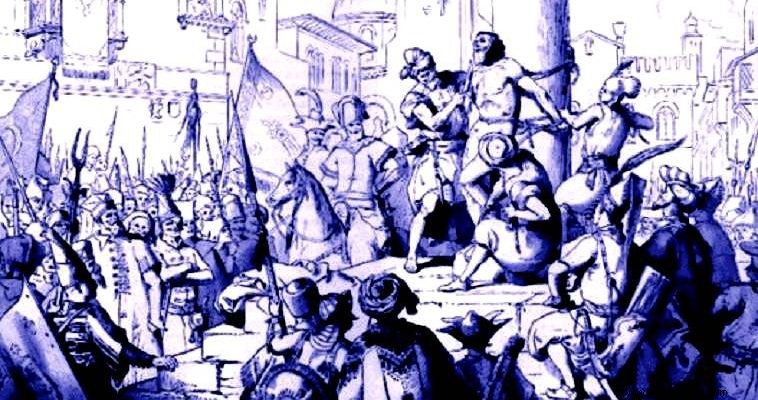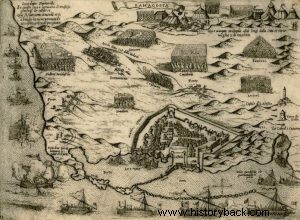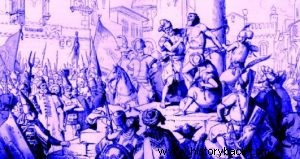
After the death of Suleiman the Magnificent, the new Sultan Selim II, immediately after ascending to the throne, decided to campaign against the Venetian-occupied Cyprus. On July 1, 1570, the Turkish armada rushed to the bay of Paphos and the next day the Turkish troops landed in Limassol, without encountering any resistance.
This was logical as the Venetian military commander of the island, Hector Vallione, only had 6,000 infantry and 500 cavalry, against 82,500 Turks. However, during their advance into the interior, the "captain of Paphos Malipietros", as the chronicles state, suddenly attacked the Turks and "destroyed many, put them to flight, and took two alive, whom he loaded with two sacks of heads"!
However, despite the brave resistance of the Venetians and Greeks, the capital of the island of Nicosia fell on September 9, 1570. This is how the archbishop of Cyprus Kyprianos describes the siege of Nicosia in his chronicle:
"So much so, in the parishes the men of the country marched in great strength, and indeed in the place of the apostles Peter and Paul, in front of the cathedral church of the Romans (Greeks), and in the vicinity, where many monks and priests of that generation were put to death, they say, like two Roman bishops.
"A crowd of great unfortunates was running in the square, crying and exhausted. And the enemy did not leave alive neither man nor woman nor infant, after all that everywhere he appeared with the knife and in one moment that beautiful city saw a shapeless sight, blood running in the streets, and reddening the ground and every little while mountains of slain.
"Whose heads, whose hands, whose feet were separated, whose brains were out, whose entrails were spilled on the ground and mixed with the pigs, who had the same fate as the citizens. At the end of the day, when the country was over, a bazaar was held, and first the beautiful children and the beautiful children were sold. They began to humiliate the children, the virgins, the chaste women, and those who opposed were beheaded!
However, the fall of Nicosia did not mean the end of the war. Famagusta was still holding. On October 1, the Turks began their attacks against the long-suffering city of Famagusta. The commander of the city, Marcos Antonios Bragantino, had at his disposal 4,000 men, soldiers and Cypriot citizens, and 200 "soldier" horsemen.
The Turks, who had meanwhile been reinforced, had, according to Archbishop Cyprian, 80,000 regular and 60,000 irregular soldiers. In the meantime, with the actions of Venice, the pope and Spain had agreed to strengthen Cyprus. For this purpose, a remarkable fleet with at least 120 warships and 25,000 Spanish soldiers had been assembled as a landing force, which shortly after the capture of Nicosia had reached the waters of Kastellorizos.
The Christian fleet, however, still did not move, leaving the besieged of Famagusta to their fate. The Turks were informed of the arrival of the Christian fleet and for the moment abandoned the siege and prepared to withdraw.
But when they learned that the Christian fleet had finally left, they became more audacious and besieged the city more closely. For better or for worse, they loaded the booty and the prisoners into a large galleon, bound for Constantinople.
But the galleon was suddenly tossed in the air, and booty and captives vanished. It is said that the daughter of the Cypriot Count Rouchia, Arnalda, managed to get to the ship's gunpowder store and set fire to the gunpowder, preferring to become a holocaust rather than continue to be dishonored by the Turks.
In the meantime, however, the besieged of Famagusta held on. Despite the continuous attacks of the Turks, the defenders, having eaten even mice and even the soles of their shoes, continued to fight.
However, not receiving any support, they decided, on August 1, 1571, to capitulate. After negotiations, the Turks promised not to disturb the besieged and to provide them with ships to go to Venetian-occupied Crete.
On August 6, the Turkish commander Mustafa Pasha entered the fortress, with their janissaries. Immediately, however, according to their favorite habit, the Turks began to violate the agreements. Even Mustafa demanded from the Venetian commander Bragantino to hand over a young soldier, "as a hostage", to abuse him.
When Bragadino refused Mustafa ordered the beheading of all the captives present. Immediately afterwards he ordered the cutting off of Bragantino's nose and his merciless torture. After brutally torturing him for ten days, he was exposed, naked on a cow, and then the executioner flayed him alive. His skin was stuffed with straw and hung on the mast of the flagship. And the bloody, pitiful Bragantino was cut in two with a saw. This is how Mustafa honored his promise.

Period engraving depicting the siege of Famagusta by the Turks.

The Turks flay alive the Venetian commander of Famagusta.
